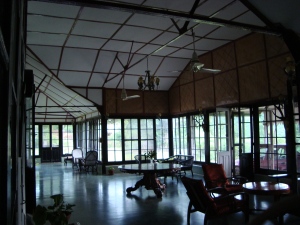After visiting Kaziranga, we left for Enthong- the village of the Singpho tribe in Assam. The Singpho were the first to discover the process of tea cultivation in India. They taught the process to the British, who then grew the Indian tea trade exponentially without giving the Singpho community their due credit. This has left a degree of resentment amongst the community, which until today sustains itself on tea farming (each household within the community maintains a plot of land for this). Today, the Singpho community in India is on the verge of extinction, with only ~25,000 remaining inhabitants. Other major Singpho hubs exist in China and Myanmar.

Manjela and Alok outside the Eco Lodge
In Enthong, we stayed at The Eco Lodge, which is run by a Singpho family. It is situated amidst the tea gardens and is entirely made of bamboo (hence the name)[i]. The manager, Manjela, plans to install solar panels to power the entire lodge over the next year, and is only using conventional electricity until the lodge raises enough funding to switch to green technology. We learned that the lodge is partly funded by the DS Group, which plans to leverage its relationship with the Singphos in its future endeavors within the hospitality space.

Manjela playing the guitar

Our room in the Eco Lodge
Food was most certainly a highlight. We were served an elaborate, yet organic and eco-friendly, Singpho dinner that consisted of delicacies such as rice steamed in bamboo sticks, spicy tomato chutney, fresh eggplant, greens and potato preparations, and yam soup. The next morning, we awoke to the sounds of a howling gibbon (an endangered animal) and Manjela playing the violin.

Our traditional Singpho meal

Anti-dandruff shampoo for Rishi
The Eco Lodge is in the district of Margarita in Upper Assam. It has 11 rooms, and while we were the only guests at the time, it is frequently visited by foreign tourists who have heard about it through word-of-mouth. However, it maintains strict rules regarding respect towards the Singpho way of life, and manages to retain a tranquil and serene atmosphere. Establishments such as these should be encouraged as they promote a healthy tourist lifestyle and open doors to relatively unexplored parts of the country.
[i] One of the reasons why eco lodges are prevalent in the northeast is because ~60% of India’s bamboo cultivation takes place here- resulting in cheap inputs.
After visiting Kaziranga, we left for Enthong- the village of the Singpho tribe in Assam. The Singpho were the first to discover the process of tea cultivation in India. They taught the process to the British, who then grew the Indian tea trade exponentially without giving the Singpho community their due credit. This has left a degree of resentment amongst the community, which until today sustains itself on tea farming (each household within the community maintains a plot of land for this). Today, the Singpho community in India is on the verge of extinction, with only ~25,000 remaining inhabitants. Other major Singpho hubs exist in China and Myanmar.










